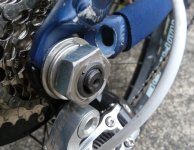teklektik said:
JP-
Very tidy repair. Thanks for posting the tale with all the photos.
Thanks.
One thing I should point out is that I did things a bit differently from tkollen's
original setup, and wanted to reinforce the reason why.
Here is a shot from the original set of images tkollen posted:
You can see that there is a flat washer and a split washer between the threaded insert and the dropout, thus reducing the available thread engagement of the insert on the axle.
While I don't have a picture of it, I used a 20mm split washer (and no flat washer), and installed the washer
after I had already threaded the insert onto the axle all the way. In other words, the end of the insert is physically touching the torque plate, so it has as much engagement on the threads of the axle as possible. The split washer which I used is between the nut and the torque plate, but does not decrease the thread engagement of either the insert to the axle nor the nut to the insert.
This is critical, as the length of thread engagement was the very core of the problem which I was having.
tkollen said:
I did grind the insert down for the cable side of the axle in order not to block the cable opening. Then I cut the thick M20 nuts to about half the thickness so that neither inserts or nuts protrude outside the end of the axle. This mod is however only aestetical and doesn't improve the function of the fix.
In my case, the wire bundle is too thick to make the turn-out through the slot cut into the axle, so this was never a concern- it has no choice but to exit the end. I guess I could see doing something like this in a case where I had more axle protruding through the dropout/torque plate, but you can see that in my case the axle is so short that I'd have had to remove way too much material from both the insert and the nut in order to expose the cutout.
I have no qualms with the wire bundle poking out the end of the axle. The baskets which I have on the bike are wide enough that the wire passes the broomstick test. (This was a concern in the event of a laydown-type accident, to prevent the wire from becoming damaged by the road.)






